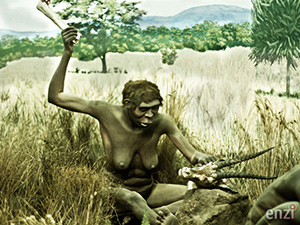Hunting and the Early humans
 Hunting has a long history and may well pre-date the rise of the Homo sapiens. Studies carried out on the early humans fossils, artefacts, fossil bones of animals that co-existed with the early humans show that for the most part our earliest Hominid ancestors were probably frugivore (chiefly fruit-eating) or omnivore (eating both animal and plant foods). Scientific evidence shows that the early Homo, and possibly Australopithecine species used large animals for subsistence.
Hunting has a long history and may well pre-date the rise of the Homo sapiens. Studies carried out on the early humans fossils, artefacts, fossil bones of animals that co-existed with the early humans show that for the most part our earliest Hominid ancestors were probably frugivore (chiefly fruit-eating) or omnivore (eating both animal and plant foods). Scientific evidence shows that the early Homo, and possibly Australopithecine species used large animals for subsistence.
Hunting is the practice of tracking and pursuing living animals (usually wildlife) for food, recreation, or trade. In present-day use, the species which are hunted are referred to as game and are usually mammals and migratory or non-migratory game-birds. The pursuit, capture and release, or capture for food of fish is called fishing, which is not commonly referred to as a form of hunting.
Excavations by archaeologists and palaeontologists at the areas where early humans lived has yielded evidence on the early man’s way of life. From the fossil bones of early humans and animals, and the sediments excavated in this archaeological sites scientists have been able to deduce the period in time that the early humans lived, how they interacted with the environment, the animals that lived there, the tools they used, what they ate, how they got their food, and the climatic conditions they faced in their time. It is possible to recreate early man’s life.
The Olorgesailie region, in southern Kenya has been a region of study by the Smithsonian Institution in conjunction with the Department of Earth Sciences at the National Museums of Kenya for many years. In one of their excavations the Smithsonian team discovered a site which has come to be known as the elephant butchery site in a layer dated 990,000 years old. At this site, they found more than 2300 stone artefacts were found surrounding the bones of an extinct elephant, Elephas recki. Many of the artefacts were sharp flakes, which could have been used to remove flesh from the elephant, as shown by cut marks on one of the elephant’s ribs, and some of the vertebrae. The excavators extended their search to nearby areas, where they found a few tools at first but eventually found other butchery sites of zebra and an antelope. This is evidence that the early humans hunted and butchered animals for meat and their nutritious bone marrow.
Hunting was a necessary activity of early humans. Throughout the palaeolithic period it was their chief means of obtaining food and hide for clothing before the domestication of livestock and the dawn of agriculture. In the Neolithic period, when agriculture developed, hunting was still important. The early man’s hunting techniques included the use of wooden or stone projectile spears which were thrown at the intended prey to fell it. About 50,000 years ago modern humans developed sophisticated hunting techniques (such as trapping pits or driving animals off cliffs). As human culture advanced, different populations of humans introduced novelty to existing technologies: artefacts such as fish hooks. The early man hunted many animals which are now extinct species of waterbuck, hartebeest, springbok, pig,caribou, zebra, antelopes and hippopotamus.
While it is undisputed that the early humans were hunters, the importance of this fact for the final steps in the emergence of the Homo genus out of earlier Australopithecines, with its bipedalism and production of stone tools, and eventually also control of fire, are emphasized in the “hunting hypothesis”, and de-emphasized in scenarios that stress the omnivore status of humans as their recipe for success, and social interaction, including mating behaviour as essential in the emergence of language and culture.
In palaeoanthropology, the hunting hypothesis postulates that human evolution was primarily influenced by the activity of hunting for relatively large and fast animals, and that the activity of hunting distinguished human ancestors from other primates. Advocates of the hunting hypothesis tend to believe that tool use and toolmaking essential to effective hunting were an extremely important part of human evolution, and trace the origin of language and religion to a hunting context.
